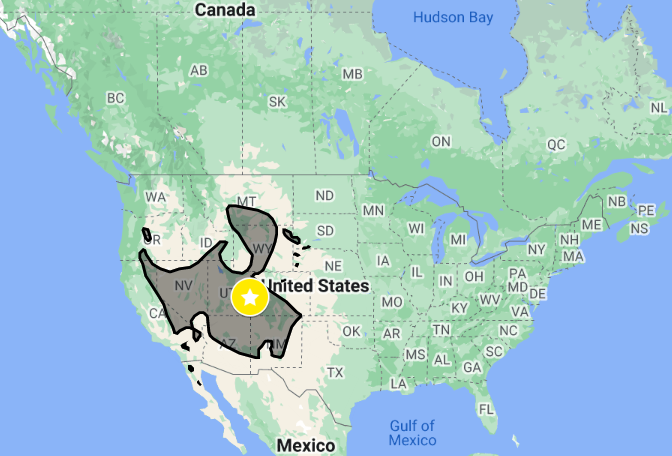Pinyons and Pines
Pinyon Jay (Gymnorhinus cyanocephalus)
Somewhere along the edges of the pinyon and juniper-lined slopes of eastern Castle Valley, you’ll find a strange little bird. It might be walking, not hopping, along the forest floor, searching for one of its thousands of seed caches. Or it might be roosted in the shrubby branch of a juniper tree, along with hundreds more of its flock nearby. This bird is the Pinyon Jay, a seven-to-nine-inch, pale blue bird with a strong black beak, specialized in extracting the seeds from pinyon cones. Pinyon Jays belong to the Corvidae family, along with Crows, Ravens, Clark’s Nutcrackers, and other Jays. Pinyon Jays, Ravens and Magpies are the most common Corvids in Castle Valley. All the birds in this family share the bold and noisy behavior, food caching abilities, and stiff feathers around the nostril. However, the Pinyon Jay is the unique exception: it lacks the nose feathers, coining it the Gymnorhinus or… “naked nose”. The Corvids are a dominant family of birds and at least one species can be found in every terrestrial North American habitat. Pinyon Jays are monogamous (meaning may mate for life) and will live with up to 300 other PJs in one flock. Both sexes (indistinguishable by plumage) with help in creating the nest where the female will lay 2-5 sub-elliptical eggs, incubating the penultimate egg first. PJs have only one brood a year and the average adult survival is 75-90% annually. All Corvids stash food in either trees or buried in the ground, digging them up regularly to check/remember where they left them. These seeds will be their source of food in winter. PJs are known to have the greatest memory of the Corvids, stashing well over 1000 caches each.
The Pinyon Jay is fundamentally intertwined with the pinyon-juniper forests that it inhabits. As for Castle Valley, the juniper dwell at lower elevations than the pinyon, mainly on the lower margins of the cliffs and up valley. The main source of food for the birds is the seeds inside the pinyon pinecones, holding lots of fat and calories. Pinyon Jays will travel together in their 50-75 bird flocks to a section of trees on the outskirts of pinyon-juniper forests and gather up to 50 or so seeds. They hold them all in a specially adapted neck pouch and then together they’ll fly five to eight kilometers away from their nesting site to a more exposed sage section of the forest to cache them in the ground. Having the pinyon seeds and juniper berries as their primary food source, the Pinyon Jays population is following the decline of these forests. Climate change is introducing more intense droughts to the already arid Southwest and Colorado Plateau and is forcing these forests’ population to drop. Century-long fire suppression in the West has led to increased fuel for megafires to rip across the country and burn pinyon-juniper forests, forcing thousands of Pinyon Jays to relocate. In a masting year (when the crop of seeds in pinyon-juniper forests is dramatically higher than the year before) Pinyon Jays will work extra hard to bury and remember every seed they can get. Even in doing so, come spring, they will have forgotten or left up to 5% of seeds in the ground, successfully dispersing the forests seeds. Pinyon Jays select caches in favorable locations in light of hospitable habitats, which closely matches with the forest's ideal habitat in turn, allowing the perimeters of pinyon-juniper forest to move towards a more habitable environment in the face of climate change.
If you were to sit on the front porch of the house at 270 Pope Ln, you could watch flocks of Pinyon Jays fly directly overhead, flapping intermittently with strong, fast strokes, calling to each other with every alight. They’d be headed east, towards their pinyon pines and junipers. Being Corvids, one of the smartest family of birds, they move across the sky with swiftness and direction, sentinel birds on lookout for danger or food. In your case, you might witness one of these sentry birds see the large amount of corn kernels or sunflower seeds you left in a feeder in the yard and change its course. You’d watch as all the little LBJ’s (little brown jabbies) scatter into hiding places amongst the Curl Leaf Mountain Mahogany or Fremont Cottonwood, giving up their space for these larger avian friends. The Pinyon Jays would roll up like a motorcycle gang, sentinel bird thrashing the corn to the ground where its family picks up the sweet seed. You’d watch the bird feeder slowly empty, and once it did, the Jays would continue their pursuit towards the familiar forests that skirt eastern Castle Valley. Their favorite candy shop at 270 Pope Lane, right on the way home. Cautiously, the Sparrows and Meadowlarks return to the feeder to clean up the scraps of the afternoon calamity. Tomorrow you’ll fill the feeder again and wait for the strange little birds to come again.
By Thomas McElfresh


